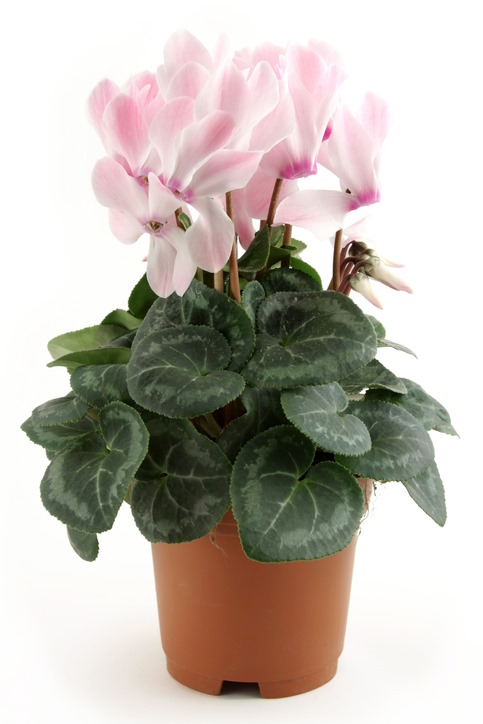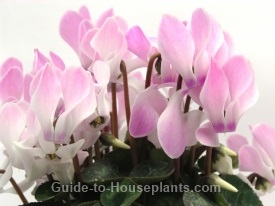
Florists’ Cyclamen plant has silver-and-green, heart-shaped leaves and a bounty of beautiful blooms. Treat it right, and you can expect months of luscious color in your home midwinter.
With this guide, you’ll discover tips for growing cyclamen as a houseplant, including how much sunlight it wants, when to water, and why you want to keep your plant.
Get to Know Cyclamen
Thanks to new hybrids, florists’ cyclamen plants are bigger, more vigorous and showier than ever before. Rising above heart-shaped, silver-and-green leaves are upright stems bearing beautiful backswept petals in shades of pink, purple, red or white.
Known by the botanical name, Cyclamen persicum, these are hybrids with origins from Southern Europe and the Middle East. If you want to know more about these beauties, you’ll find a wealth of information at cyclamen.org.
How big does cyclamen plant get? These florist plants will reach a height of 6-12 in (15-30 cm) tall.
Is it poisonous to pets? Yes, according to aspca.org, cyclamen contain terpenoid saponins that is toxic to cats and dogs.
Are the flowers fragrant? Probably not. Generations of careful selection and breeding has wiped out the fragrance from the original cyclamen plants. The trade-off is an abundance of oversized flowers that deliver months of captivating color for your home.
New Houseplant Do’s and Don’ts
If your florists’ cyclamen just came home with you, there are a couple things you should know right away.
Remove any foil or plastic pot covering. Why? Although the decorative wrapping may look pretty, it’s blocking the drainage holes in the bottom of the pot. One of the things cyclamen won’t tolerate is soggy soil.
Don’t repot. I know, you just removed the pretty wrapping, and now you’re looking at a plain plastic pot. However, repotting a flowering houseplant stresses it, and it may protest by dropping its blooms. You don’t want that. If you want to cover a plain nursery pot, drop it into a cachepot — a decorative pot without drainage holes. I put small rocks in the bottom of cachepots to keep the inner pot above the drainage water.
Keeping Your Cyclamen Plant
Winter-blooming cyclamen plant is usually bought in flower from the florist and treated as an annual, then unfortunately, is tossed out when it begins to deteriorate in spring. However, cyclamen plant is a perennial that you can enjoy for years.
With good care, this cool-season, flowering house plant will last for several months, then can be brought back to bloom the next winter. When flowers die and foliage turns yellow, cut it back. Put the dormant plant in a cool, dark spot for the summer and allow it to dry out. In fall, put the plant back in bright light and resume watering and fertilizing. Blooms should appear in 2-3 months.
Indoor Cyclamen Problems and Cures
Sudden wilting of leaves and flower stems is caused by dry soil. Don’t worry — they’ll usually come right back after a thorough watering. Stems and flowers that don’t respond can be pinched off.
Shriveled, yellow leaves are a symptom of too-warm temperatures. Remember, this beauty likes it cool. Cut off any dried leaves to keep your houseplant looking its finest.
Wet soil and poor ventilation may cause botrytis — a gray, fuzzy fungus that can quickly kill the plant. Yellowing leaves with brown patches are a sign of botrytis. Cut off the affected leaves. Cutting off spent flowers and any yellow or shriveled leaves will help air circulation around the plant and help prevent the fungus from growing. If the plant is badly affected, get rid of it.
Aphids and spider mites and cyclamen mites are possible pests. Look over your plant every time you water for these destructive pests. Aphids tend to hang out on stems and new growth. You’ll notice the presence of mites by the webbing between stems and leaves. Cut off affected leaves and treat any infestation immediately with a neem oil insecticide.
 Photo istockphoto.com
Photo istockphoto.comBuying Tips
There are hundreds of cyclamen hybrids to choose from. Many are not even named, making it difficult to recommend one.
Some petals are striped, frilly or tipped with a contrasting color. A few varieties are sweetly scented. Miniature cyclamens are charming, reaching only 5 in (13 cm) tall.
Vibrant blooms make them must-have house plants. Even their lacy leaves are beautiful. Set one on a plant stand to show it off.

Indoor Cyclamen Plant Care
Light: Bright light. Some direct winter sun is okay. Don’t have a sunny window? Cyclamen responds well to artificial light.
Water: Keep soil lightly moist at all times. It’s best to water cyclamen plant near the edge of the pot, not over the crown, which may cause it to rot. Or water from below by placing pot in a saucer of tepid water for no more than 20 minutes.
Humidity: Moderate (around 40-50% relative humidity). Increase humidity with a cool-mist room humidifier or a humidity tray.
Temperature: Cool temperatures 55-70°F/13-21°C year-round. It will tolerate a low of 40°F/4°C. Your cyclamen will last longer if you keep the plant away from blasts of hot or cold air from doorways and air vents.
Soil: Good-quality all-purpose potting mix
Fertilizer: Feed every 2 weeks with high-phosphorus fertilizer diluted by half only while plant is budding and blooming.
Propagation: Cyclamen seeds are tiny, and slow to germinate. Sow seeds in late summer through fall. They must be kept at 70°F/21°C to germinate; use a heating mat to maintain warmth. You’ll wait about a year and a half for most varieties to bloom.






